Time over motivation
Comparison of the engagement and completion of synchronous and asynchronous online courses for adult learners

Intro
- Matthew Gemmell (he/him)
- Microbiology background
- CGR (UoL) & NEOF
- Bioinformatics trainer
- Since 2015
- 10-15 workshop p/a
- > 65 workshops



Contents
Review and investigation of best approaches
- PGCAP
Online courses
Synchronous vs asynchronous approaches
Bioinformatics
Working adult academics


Online courses
- Online/networked/E-learning: IT used to promote connections
- Learners
- Leaner & tutor
- Learning community & learning resources
- (Goodyear et al, 2005)
- Now commonplace

Synchronous and asynchronous
- Synchronous
- Interacting parties are present at the same time
- E.g. Presentations and practical walkthroughs
- Asynchronous
- interacting parties are not present at the same time
- E.g. recordings and materials learners can work through at their own time
- Advantages and disadvantages to each

Previous comparisons of synchronous and asynchronous
- Some studies shown no to very little difference in learning outcome
- (Olson & McCracken 2015, Shahabadi et al, 2015)
- Study of students learning word processing (Ogbonna et al, 2019)
- Both increased cognitive academic achievement
- Asynchronous approaches showed higher cognitive achievement

Teaching context
- Many different teaching approaches
- Best to adopt good practices and avoid poor practices (Race, 2019)
- Choice is based on
- Suitability with tutor
- Topic
- Learners
- More

Bioinformatics (bfx)
- Multi disciplinary topic
- Genomics, Computer science, & Statistics
- 2 main types of bfx learners
- Life scientists
- Computational background
- I primarily teach life scientists
- Assume basic level of biology
- Can’t gain benefit of interaction with computational-based learners

Master as a Service
- Approach for multi disciplinary topics
- Partner learners from different backgrounds
- Initial reluctance by students
- End point:
- Students highly satisfied
- Benefited from learning skills and knowledge of students from other backgrounds
- (Navarro et al, 2019)

Working academic adults
- PhD students, ECRs
- Abundance of motivation
- Want and/or need to learn (Taylor & Hamdy, 2013)
- Know what they need to learn (Kara et al, 2019)

- Low in time
- Full time jobs, Household tasks, & Caring responsibilities (children/dependants) (Cercone, 2008)
Case study
Literature review
Survey
- Likert scaled questions
- Open questions
Online courses
Synchronous and asynchronous
Engagement & completion
Advantages and disadvantages

Survey
- Google form
- Ethics disclaimer and collective ethics approval form
- University of Liverpool staff (8 responses)


Course attendance and engagement
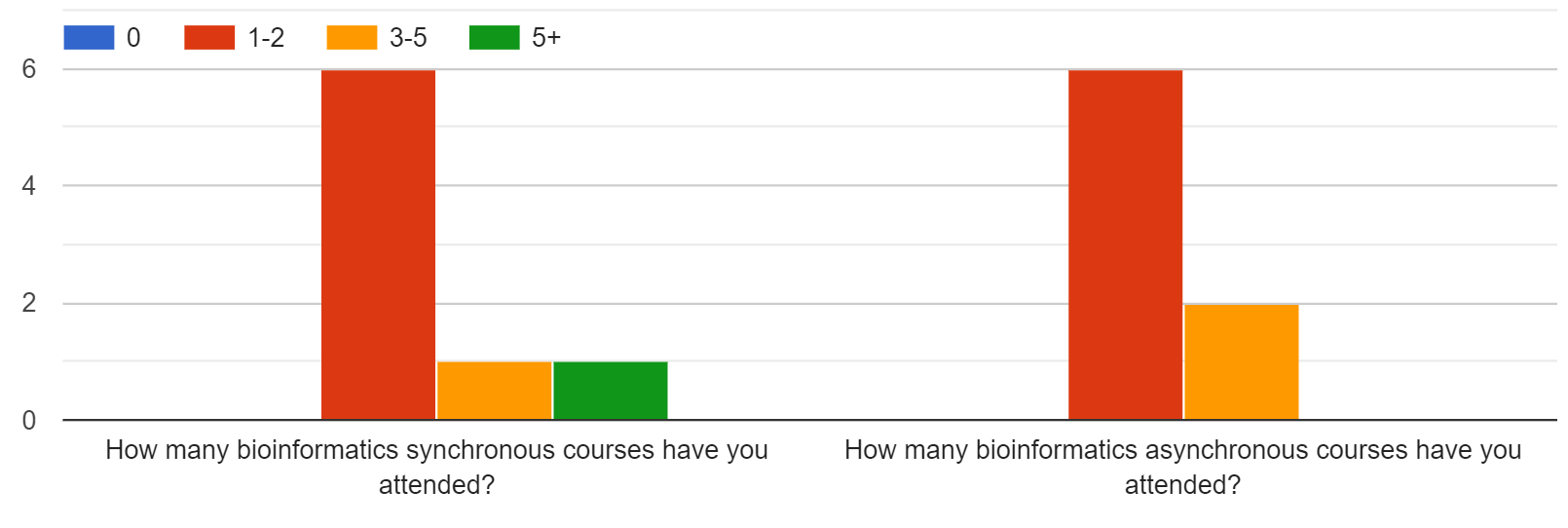

Breakdown
| Synchronous course attendance | Asynchronous course attendance | Synchronous course engagement | Asynchronous course engagement |
|---|---|---|---|
| 1-2 | 1-2 | 4 | 4 |
| 1-2 | 1-2 | 4 | 2 |
| 1-2 | 1-2 | 4 | 2 |
| 1-2 | 1-2 | 2 | 4 |
| 3-5 | 3-5 | 5 | 3 |
| 1-2 | 1-2 | 4 | 4 |
| 1-2 | 1-2 | 5 | 4 |
| 5+ | 3-5 | 5 | 3 |
Engagement
- More likely to engage and complete synchronous courses
- Dropouts are a crucial problem of adult learning (Park & Choi, 2009, Choi & Kim, 2018)
- Studies have found limited engagement in pre-class materials in higher education (Al-Zahrani, 2015)


Synchronous advantages
How beneficial do you find:
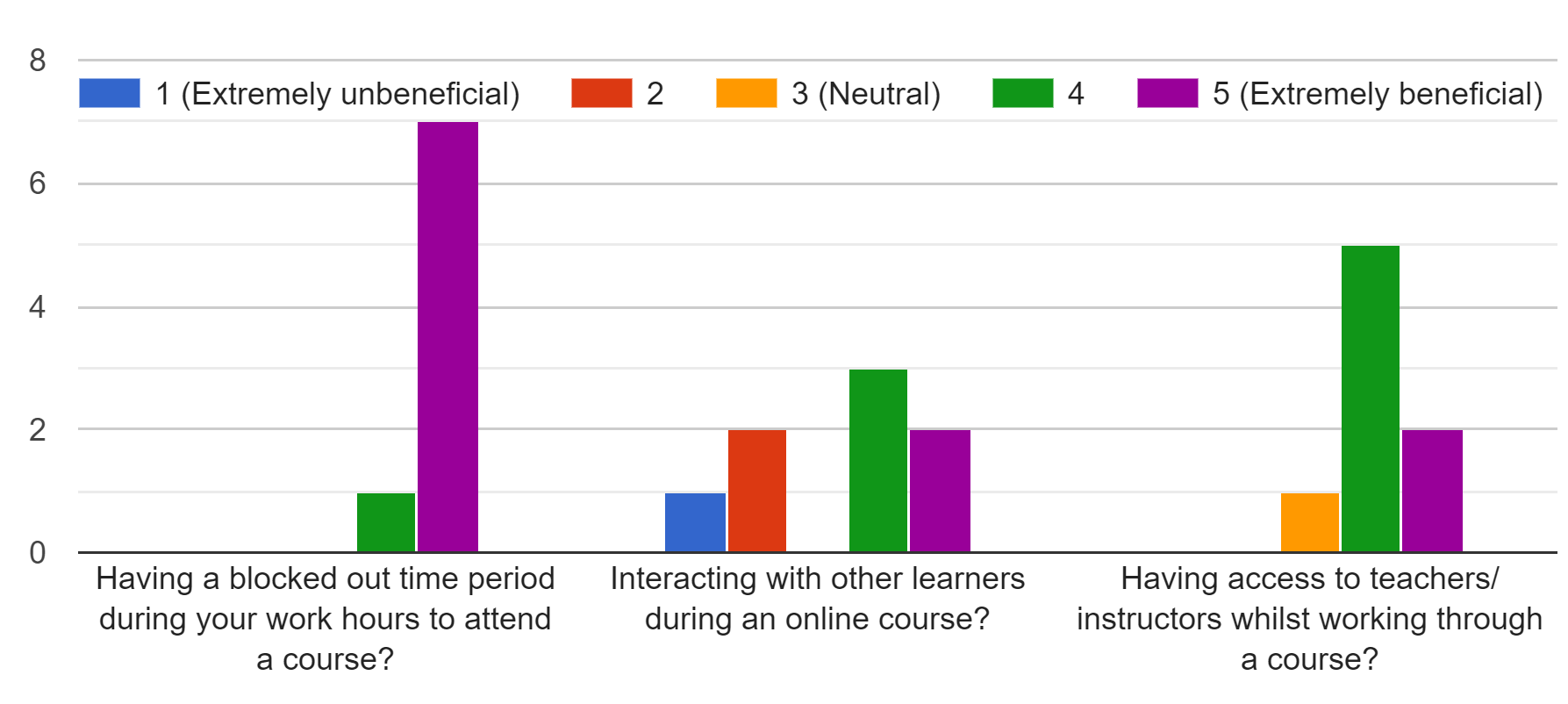
Blocked out time
- Response with highest perceived benefit
- All responses extremely beneficial (bar one beneficial)
- Easier to get break when event in calendar
- Low time, especially:
- middle-aged adults (36-55)
- female learners who are married and have children
- (Selwyn, 2011, Kara et al, 2019)

Synchronous advantages
How beneficial do you find:

Learner-learner interaction
- Mixed response
- 5 beneficial
- 3 unbeneficial
- No neutrals
- Discussion with fellow learners
- Share struggles and solutions
- Distraction from course
- Zoom quiet room
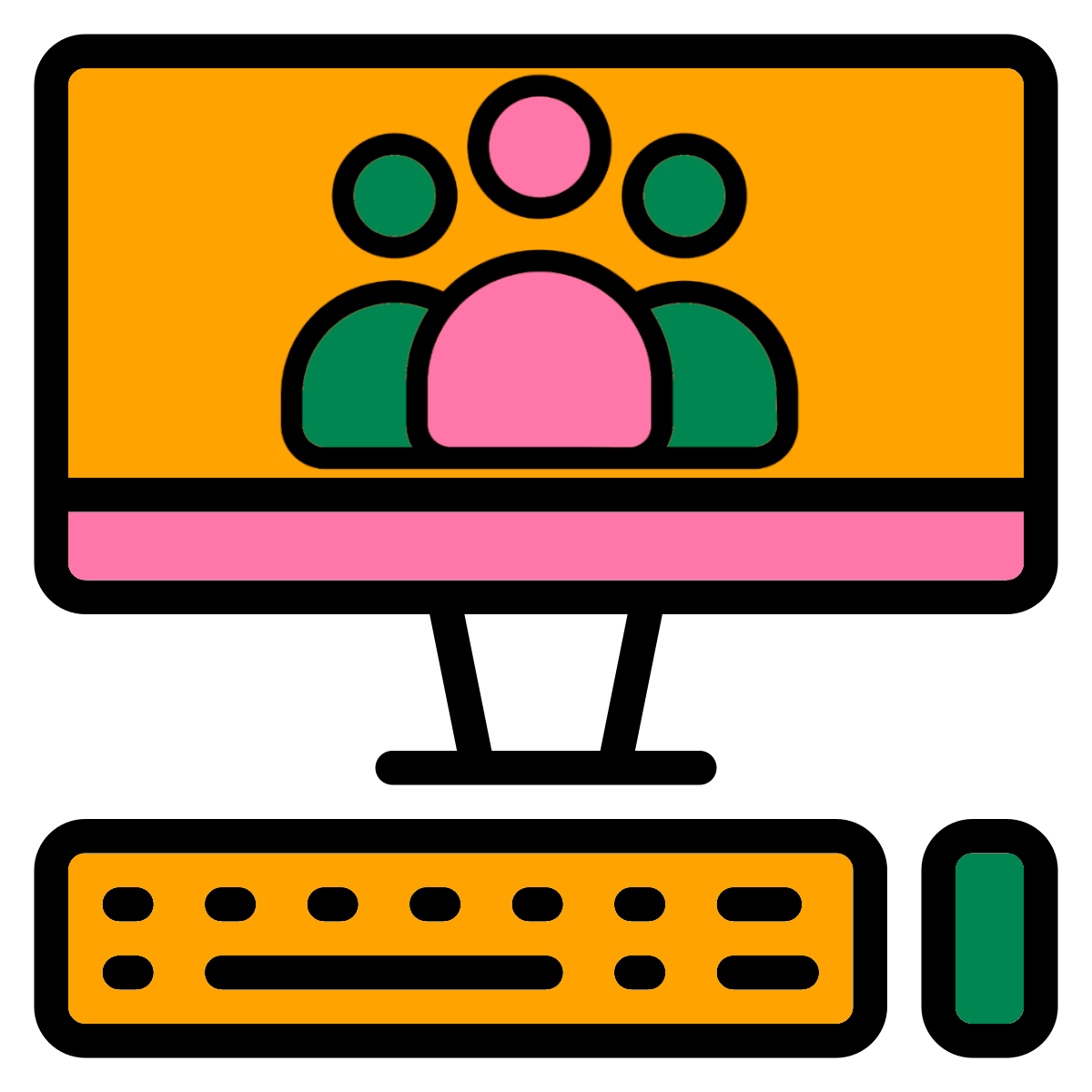
Learner community
- Immediate peer interaction promotes learning
- Learners assist and encourage (Dao et al, 2022, Philp et al, 2013)
- Synchronous learning can create a community
- Prevent feelings of isolation and separation (Öztürk, 2021)

- Adult learners find it difficult to develop social bonds with other learners online (Furnborough, 2012; Zhang & Krug, 2012)
Synchronous advantages
How beneficial do you find:

Tutor access
- Primarily beneficial
- Prompt feedback is good practice
- Expected by students (Johnson, 2014)
- Correct tutor interactions with learners
- Promotes deep learning approach (Hardman, 2016)

Troubleshooting/debugging
- Bfx involves coding and programming
- Typos, mistakes, and errors
- Strong negative emotions
- Confusion, frustration, & anger
- Rapid demotivation
- (Kinnunen & Simon, 2010)
- Most bfx tools are open source
- Significant barrier to entry
- (Ngo et al, 2021)

Tutor assitance
- Bfx benefits from immediate help
- Resolve issues & encouragement
- Teach troubleshooting skill
- Skills are vital (Li et al, 2019)
- Study (Whalley et al, 2021)
- Formal education
- Computational troubleshooting
- Students valued taught skills

Ineffective tutor interaaction
- Limited interaction
- Late or no response
- Poor feedback
- Lack of synchronous assistance
- (Joo, 2014; Dumais et al, 2013; Dzakiria, 2012; Östlund, 2005; Pierrakeas et al, 2004)

Synchronous course timing
- Best timing is 10am - 4pm
- Allows adults time for other responsibilities
- Prevent cognitive overload
- Less energy
- Our learners typically leave between 3pm and 4pm

Day break
- Online course allows a day break
- Low perceived benefit
- Beneficial to tutors
- Recharge energy levels & fix any issues
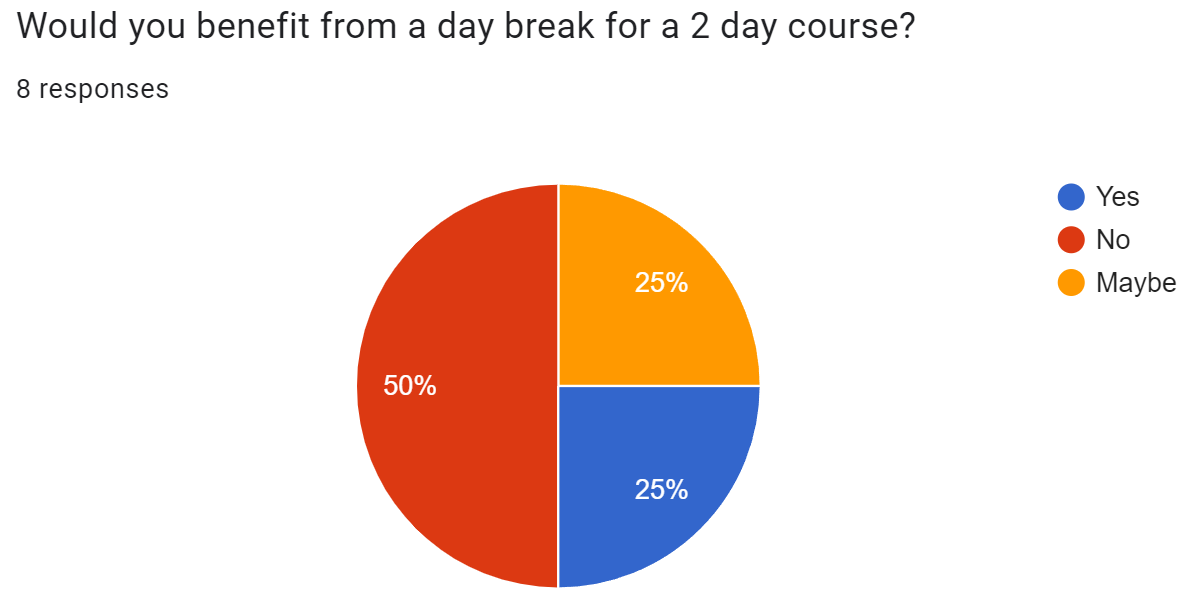
Synchronous open question
Question: Are there any other features of synchronous online courses you find particularly beneficial? Do you have any other comments about synchronous online courses?
| While I see better engagement in synchronous courses, I get even more so with those in-person as opposed to online. For example, more likely to ask for help/questions at in-person courses as opposed to online. |
| Having someone be able to explain why something works/doesn’t work |
| If the cohort is small, of a similar level of understanding and feel comfortable to engage, it’s a great learning environment. |
| The limited time-frame does force more attention and so internalisation of knowledge vs more asynchronous work. The latter is more passive and easier to lose focus. |
Takeaways from synchronous open question
- Two voiced preference for synchronous courses over asynchronous
- One preference for in-person courses
- Good structure and environment is vital
- Keep learners focussed
- Open for questions and assistance
- Many practices to attempt this

Bioinformatics is difficult
- Multidisciplinary topics are difficult
- Lots of unfamiliar skills
- Multiple concepts interacting at once
- Asynchronous courses better suited to less complex foundational topics (Sindiani et al, 2020)
- Work at their own pace
- More time to focus on synchronous classes of more complex topics

Fast evolution of bioinformatics
- Constant improvements
- Sequencing approaches and technologies
- Databases size and completeness
- New and existing tools

- Difficult for teaching programs & technical experts to keep pace (Navarro et al, 2019)
- Materials need to be updated regularly
- Synchronous courses don’t need to re-record videos

Asynchronous advanatages
How beneficial do you find:
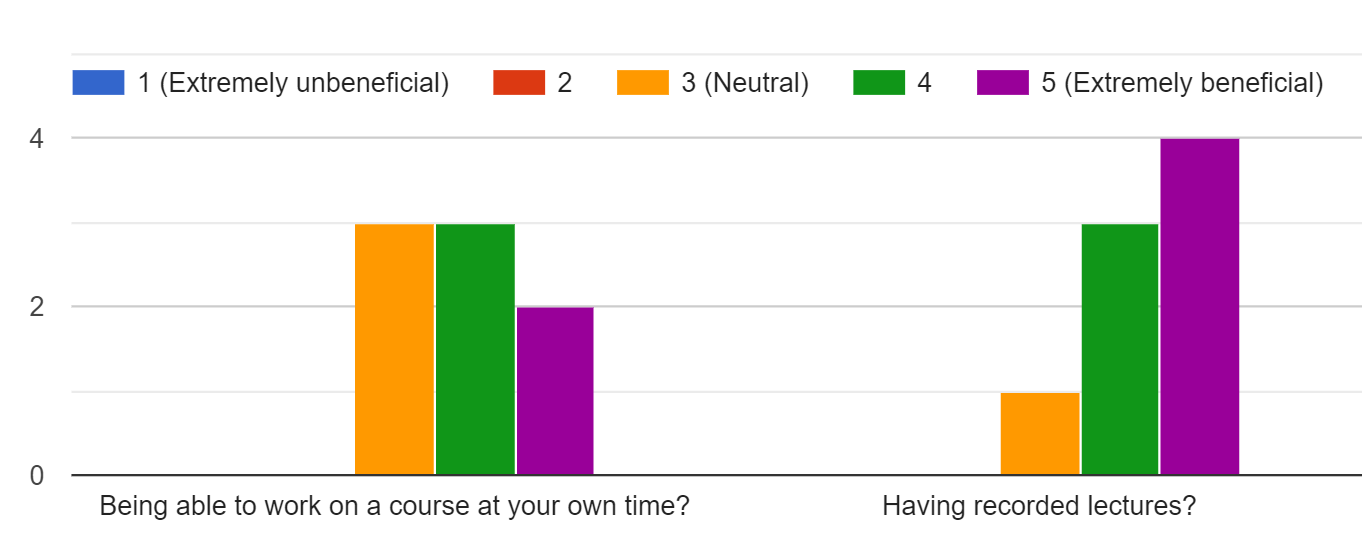
Own time
- Slight benefit
- Lower than blocked out time
- Previous research
- Benefit in learners working at own pace and time
- (Akuratiya & Meddage, 2020, Clark et al, 2011, Coogle & Floyd, 2015)

Recorded lectures
- Very beneficial
- Instant access to E-materials and online lectures are beneficial to learning (Ayu, 2020).
- Future use

- Asynchronous courses do not require a stable Internet
- Issue of online synchronous courses (Woodcock, 2023).
- Didn’t specify pre recorded lectures or recordings of attended lectures
Asynchronous open question
Are there any other features of asynchronous online courses you find particularly beneficial? Do you have any other comments about asynchronous online courses?
| It is nice to be able to do at your own pace. I do find though I’m more likely to drop off a course like this instead of follow through to completion. I’ll sometimes look through asynchronous material to find answers to a specific question or issue I have, as opposed to do the whole course, which is probably worse for general understanding of a topic |
| Being able to skip/skim things I understand better to focus on things I’m struggling with |
|
| It is difficult to find time and when you find time it may be difficult to progress if you need to wait for support |
| Good structure and progression of the course is important |
Takeaways from asynchronous open question
- Structure important and
- Limitations are required
- Asynchronous course as a resource
- Overcome issues
- Find specific tools and knowledge
- Lack of support is an important detriment
- Self-paced and individual approach can be a boon

Further comments
“Do you have any further comments or feedback?”
- None, best of luck with PGCAP research


Combining approaches
- Best method
- Many students are in favour of a blended approach
- (Perveen, 2016, Xie et al, 2018)
- Disadvantages of one approach compensated by the other

Flipped classroom
- Class is at home
- Homework is in the classroom
- Improves performance in learning
- (Akçayır & Akçayır, 2018, Strelan et al, 2020).

Our synchronous approaches
- 10am - 4pm
- Tuesday & Thursday
- Lectures during course
- Materials at own pace
- Theory, practice, & exercises
- Welcoming environment
- Tutor access & learner community
- Flexibility
- More traditional approach for tutor

Our asynchronous approaches
- Prerequisite materials (e.g. Linux)
- Post course materials
- Course materials
- Files & installation instructions
- Recorded lectures
- Further resources

Recap
- Synchronous and asynchronous
- Different advantages and disadvantages
- Bioinformatics
- Multidisciplinary, difficult, & rapidly changing
- Working academic adults
- High motivation
- Low time: Need scheduled event

- Consider tutors, topic, and the learners
Thanks! & Thanks to:
- NEOF training subgroup
- PGCAP coordinators & teachers
- CGR


Main website: https://m-gemmell.github.io/
Slides: https://m-gemmell.github.io/PGCAP
Survey & Ethics disclaimer
| Survey to compare benefits of Synchronous and Asynchronous bioinformatics online workshops |
If you are a PhD student or staff member of the University of Liverpool I would appreciate you filling out the below survey. This is to carry out my scholarly research for my PGCAP (https://www.liverpool.ac.uk/eddev/supporting-teaching/pgcap/). Definitions: Synchronous: Interacting parties present at same time. I.e. the instructors and students gather at the same time and place (virtual or physical). Asynchronous: Interacting parties not present at same time. I.e. the students work at their own time and place separate to the instructors. Ethic disclaimer You are being asked to participate in a research study that aims to to compare benefits of Synchronous and Asynchronous online workshops. As a part of the study, you will be asked to answer the questionnaire. Your participation is completely voluntary. Completing the questionnaire should take ~10 minutes. Rest assured that you can stop participating at any time and your answers to the survey will be kept anonymous and confidential. Emails will not be captured for this survey. Note: A collective ethics approval has been carried out for this survey for University of Liverpool students and staff. Please do not hesitate to contact Matthew Gemmell (mgemmell@liverpool.ac.uk) if you have any questions about the project or the survey. |
Citations
|
